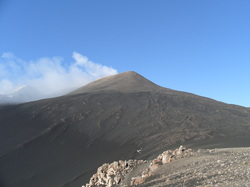 The plume of the NEC in September 2012. The plume of the NEC in September 2012. Recent research published in Geophysical Research Letters by Tamburello et al. (2013) has demonstrated that Sulphur Dioxide emissions can vary rapidly over very short timescales during passive degassing (see previous post for info on passive degassing). The study also demonstrates that there are links between the emission of Sulphur Dioxide and Seismicity over certain periods. This is achieved by taking high resolution readings of Sulphur Dioxide using UV cameras every second or so, which allows the comparison of the Sulphur Dioxide and Seimsic datasets at this high resolution. Great! But what does this mean? In short it means that the two process are potentially linked over these timescales, which could implicate that gas emissions are driving seismicity (I am sure there are other possibilities though...). It confirms that volcanoes such as Etna are very dynamic and that sub-surface processes (which almost inevitably cause these fluctuations) rapidly alter the gas emissions that are recorded at the surface (or vice-versa). This is where my PhD research kicks in, why are we seeing these changes over these timescales? What is causing these very periodic structures? Of course this trend in emissions is not just seen at Etna but at other volcanoes worldwide. It could therefore be important for understanding the state of shallow magma pathways and storage areas in basaltic systems generally. Comments are closed.
|
Archives
July 2023
|

 RSS Feed
RSS Feed